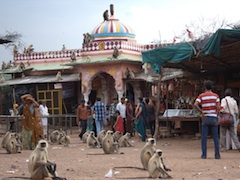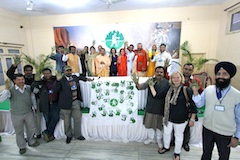| |
|
 |
Indian Conservationist discovers religious allies
January 28, 2014:
 |
 |
 |
Monkeys near a temple in Ranthambore eating plastic bags left by pilgrims. |
In a challenging posting entitled 'Time to unite religion with conservation' Indian blogger Dharmanda Khandal sees a partnership with religious organisations as vital to address the environmental impact of pilgrims visiting holy shrines in India's national parks.
As a conservation biologist with Tiger Watch Ranthambore
Mr Khandal was carrying out a survey of the Ranthambore National Park - one of the newer members of the Green Pilgrimage Network's India Chapter
- when he received an invitation from ARC's Chantal Elkin to attend a Green Pilgrimage Network meeting in Rishikesh. He describes the impact of this encounter in the opening paragraphs of his posting:
"Most national parks and sanctuaries in India are full of religious places. I surveyed Ranthambhore national park to find how many temples and mosques exist in it and was amazed to find that in the 400 sq km area of the park, the number of active religious places is not less than 100! All these 100 places are regularly visited by hundreds of thousands of people. As a result, they are dirty and littered as visitors often carry food for themselves as well as to feed the wild animals. What’s more, visitors also sing bhajans at quite a loud pitch, creating further disturbance in the park. The situation seems quite uncontrollable, really — all naturally dripping places get converted into Shiv temples and all big rocks get painted red and turned into Hanuman or Bhairav temples. We can continue talking about the tourism regulation, but even the law in India seems to have no control over religious issues.
 |
 |
 |
Delegates at the GPN meeting in Rishikesh |
During the survey, I got a mail from conservationist Chantal Elkin about a workshop in Hrishikesh on conservation and religion. She was planning this workshop with the help of the famous Parmarth Niketan Ashram. When I saw her invitation and objective, it set me thinking — if we convert these religious places positively, they could become big support groups for wildlife. I realised that conservationists need to refocus on strategies that reshape ethical attitudes to nature and encourage pro-environmental thinking and lifestyles. Religions are central to basic beliefs and ethics that influence people’s behaviour and should be considered more seriously in biodiversity discourse.
If we look closely, rich cultural and religious sentiments are positively supportive towards the wildlife of our country. Various wild animals are associated with god and goddesses. Many big cats and other powerful animals live in close proximity to human settlements and people too co-exist without much objection to their presence."
The blog goes on to describe how this realisation fundamentally changed the way in which Mr Kahndar wrote his report on Ranthambore. Rather than simply criticising the religious organisations he recommended engaging them in partnership, concluding that: "Religion and science are the two most powerful forces in the world today. If we could be united on the common ground of biological conservation, the problem would soon be solved."
Useful links'Time to unite religion with conservation'
Ranthambore National Park
Green Pilgrimage Network
Green Pilgrimage Network's India Chapter
Green Pilgrimage Network meeting in Rishikesh
Tiger Watch Ranthambore
|
 |
 |
|
|
|
|
|
 |
Green pilgrimage network members
The vision is of pilgrims on all continents and the pilgrim cities that receive them, leaving a positive footprint on the Earth |
 |
Ranthambore Tiger Reserve
Introductory information about new Green Pilgrimage Network member Ranthambore Tiger Reserve, India, joining at Trondheim July 2013 |
 |
December 27, 2012:
Green Pilgrimage Network meeting in Rishikesh
Last month the Bhumi Project and ARC hosted a unique meeting of pilgrim towns, cities and sites in India as part of the Green Pilgrimage Network's India chapter. |
 |
 |
|
|

